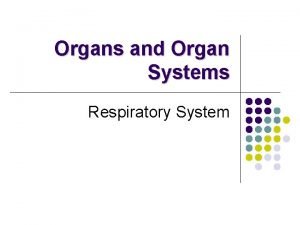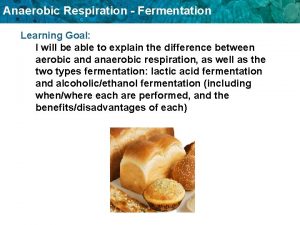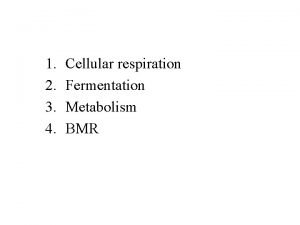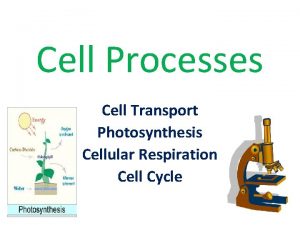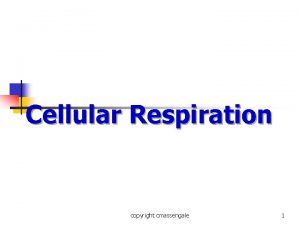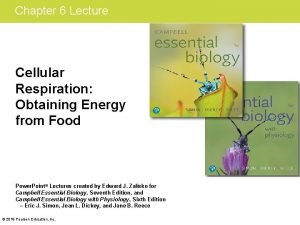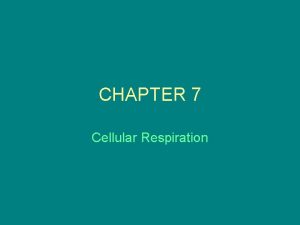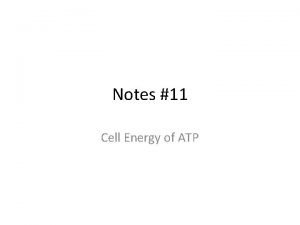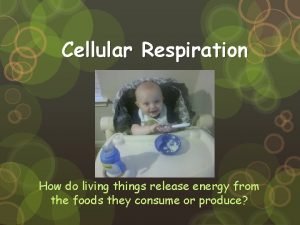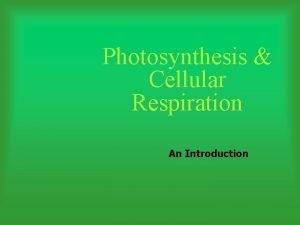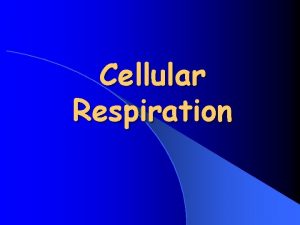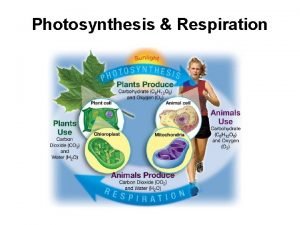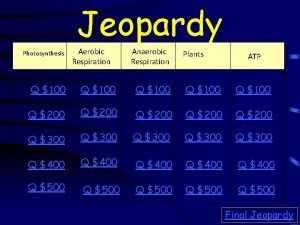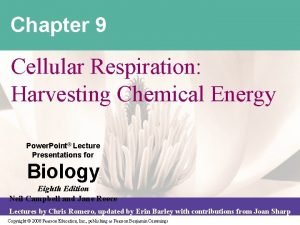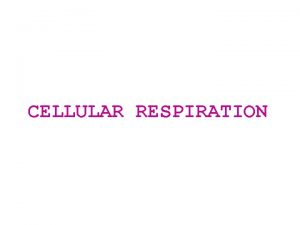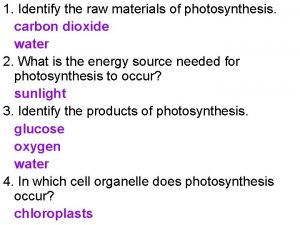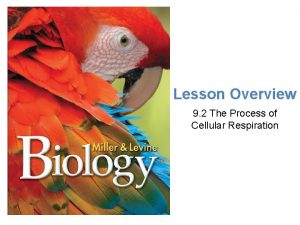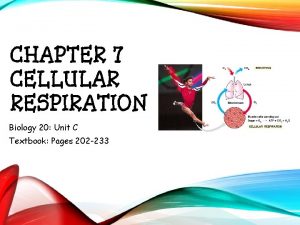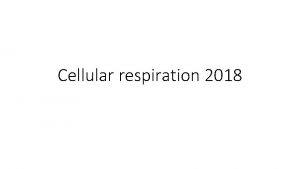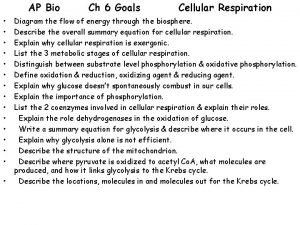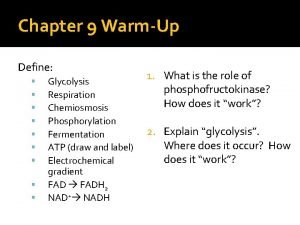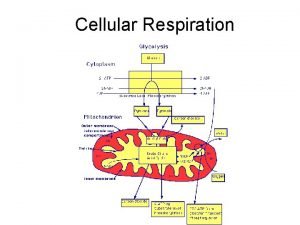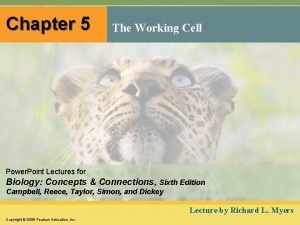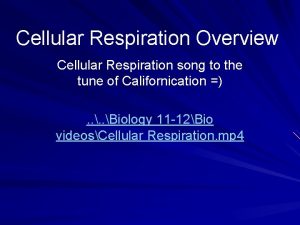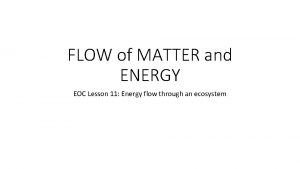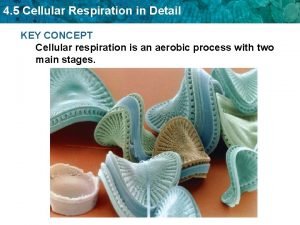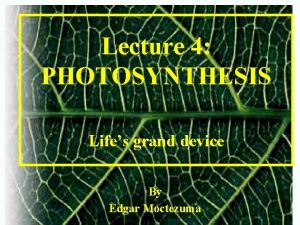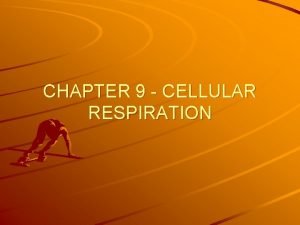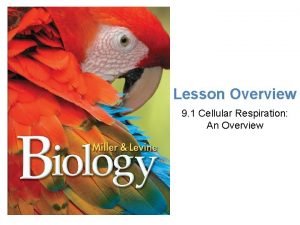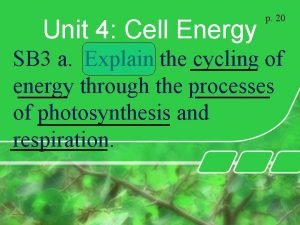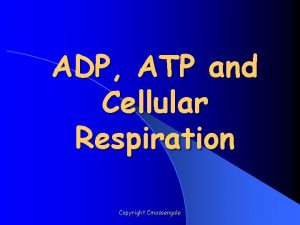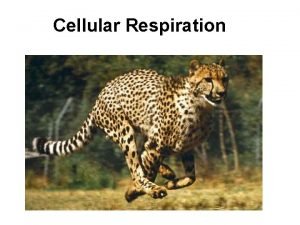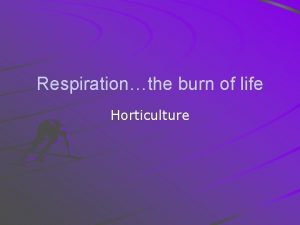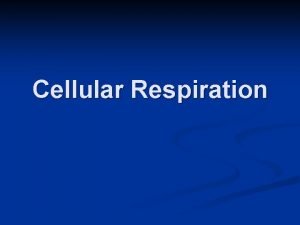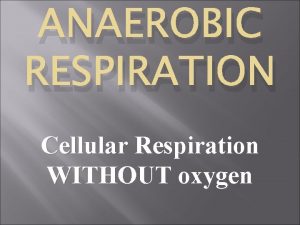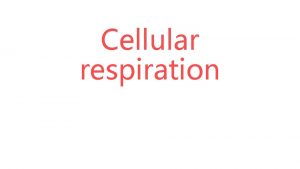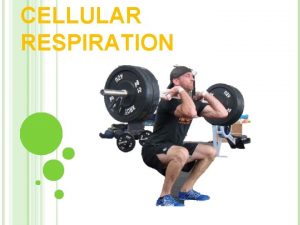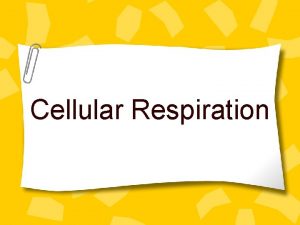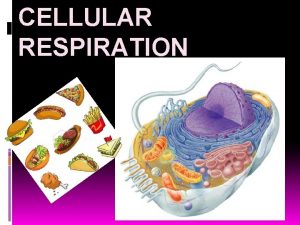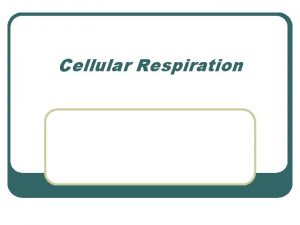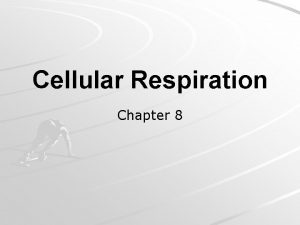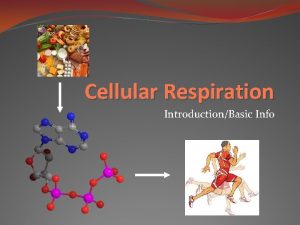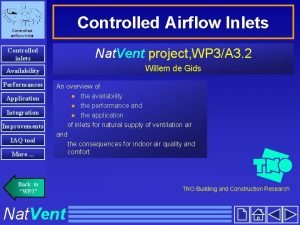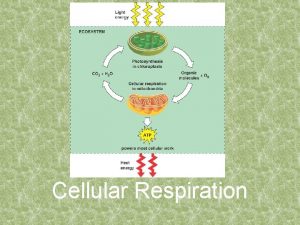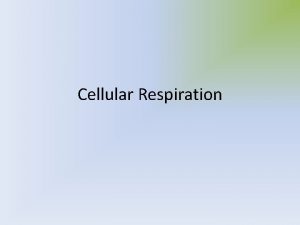CELLULAR RESPIRATION CELLULAR RESPIRATION A Cellular respirationthe controlled









































- Slides: 41


CELLULAR RESPIRATION

CELLULAR RESPIRATION A. Cellular respiration=the controlled release of energy in the form of ATP B. -Can be aerobic or anaerobic C. ATP=adenosine triphosphate -a chemical that can diffuse to any part of the cell and release energy -made from organic compounds in the cells through cellular respiration

OVERALL PROCESS A. Organic compounds + oxygen → carbon dioxide + water + energy B. Food is the fuel for cellular respiration -food=organic compounds (carbs/fats/proteins) C. Cellular respiration is a catabolic pathway (it releases energy by breaking down complex molecules)

• ATP IS RECYCLE BY THE CELLS ATP + H 2 O → ADP +Pi + energy • ATP is hydrolyzed to form ADP, inorganic phosphate and energy -An exergonic reaction C. The inorganic phosphate will attach to another ATP molecule D. The new ATP molecule is phosphorylated ADP + Pi → ATP + H 2 O -This an endergonic reaction

REDOX REACTIONS A. Cellular respiration involves movement of electrons (gain or loss) B. Redox reactions indicate movement of electrons C. Oxidation= -gain oxygen -lose electrons D. Reduction= -gain electrons -lose oxygen

REDOX REACTIONS E. Two ways to remember 1. OIL RIG (refers to electron movement) -oxidation is loss -reduction is gain 2. LEO the lion goes GER LEO (lose electrons oxidation) GER (gain electrons reduction)

REDOX REACTIONS F. The most common carrier is NAD+ G. H atoms have one proton and one electron H. When two H atoms are removed from a substrate NAD+ accepts the electrons from both atoms and a proton from one of them I. NAD+ + 2 H→ NADH + H+

REDOX REACTION NAD+ +2 H+ Has no charge because it took the electron from the free H to neutralize the original NAD+ NADH+H+ because its electron is attached to the NADH

• NAD+ + 2 H→ NADH + H+ Oxidation Reduction Gain oxygen Lose hydrogen Gain hydrogen Lose electrons Gain electrons

GLYCOLYSIS • Glycolysis-’splitting of sugar’ (1 st step of cellular respiration) • Break down of glucose into 2 pyruvate molecules • One 6 -carbon sugar is broken down into two 3 -carbon sugars • Takes place in the cytoplasm (a. k. a. cytosol) • Oxygen is not required for glycolysis

GLYCOLYSI S Glucose ATP ADP Glucose-6 -phosphate Fructose-6 -phosphate ATP ADP Fructose-1, 6 -diphosphate Glyceraldehydephosphate Dihydroxyacetone phosphate *these two are isomers of each other*

GLYCERALDEHYDEPHOSPHATE NAD+ NADH + H+ 1, 3 diphosphoglycerate ADP ATP Dihydroxyactetone phosphate NAD+ NADH + H+ 1, 3 -diphosphoglycerate ADP ATP 3 -phosphoglycerate 2 -phosphoglycerate Phosphoenolpyruvate ADP ATP Pyruvate

GLYCOLYSIS (AN OVERVIEW) Glucose + 2 ADP +2 Pi + 2 NAD+ → 2 Pyruvate + 2 ATP + 2 NADH +2 H+ +2 H 2 O

GLYCOLYSIS (ANOTHER OVERVIEW) 6 carbon sugar 2 ATP 2 ADP + 2 Pi Phosphorylated 6 C sugar 3 C sugar NAD+ NADH + H+ ADP + Pi ATP Pyruvate

GLYCOLYSIS (THE PRODUCTS) A. Overall products -2 Pyruvate -2 ATP -2 NADH -2 H+ -2 H 2 O B. NAD+ is reduced to NADH C. 6 carbon sugar is broken down into two 3 -carbon sugars D. The 3 -carbon are oxidized to pyruvate

OXIDATIVE DECARBOXYLATION (THE LINK REACTION) A. Pyruvate gets converted into acetyl coenzyme A (acetyl Co. A) B. This step is between glycolysis and the Kreb’s cycle C. Occurs in the mitochondria D. Pyruvate + Co. A + NAD+→ Acetyl Co. A + CO 2 + NADH + H+


THE KREBS CYCLE (A. K. A THE CITRIC ACID CYCLE) • • After glycolysis, if oxygen is present, the pyruvate molecules move from the cytoplasm to the mitochondria. Then they go through oxidative decarboxylation (the link reaction). Next step=Krebs cycle

THE KREB’S CYCLE • Kreb’s cycle=a metabolic process that completes the breakdown of glucose -occurs in the mitochondria and starts with pyruvate molecules that were produced in glycolysis -requires oxygen, thus it is part of aerobic respiration

THE KREB’S CYCLE

THE KREB’S CYCLE • Products of Krebs cycle 2 CO 2 1 ATP Per turn of the Krebs cycle 1 FADH 2 3 NADH + H+

OXIDATIVE PHOSPHORYLATION AND THE ELECTRON TRANSPORT CHAIN A. General electron pathway food→NADH→ETC→oxygen B. ETC is a series of electron carriers located in the inner membrane of the mitochondria

OXIDATIVE PHOSPHORYLATION AND THE ELECTRON TRANSPORT CHAIN C. NADH supplies two electrons to the ETC NAD+ + 2 H→ NADH + H+ D. In the ETC electrons move through the chain reducing and oxidizing the molecules as they pass E. The ETC is made mostly of proteins F. The NADH molecules transport the electrons to the ETC -FADH 2 is added at a lower energy level

OXIDATIVE PHOSPHORYLATION AND THE ELECTRON TRANSPORT CHAIN G. The electrons move down the mitochondrial membrane through the electron carriers H. A concentration gradient is generated -positive in the intermembrane space

OXIDATIVE PHOSPHORYLATION AND THE ELECTRON TRANSPORT CHAIN I. At the end of the ETC oxygen accepts hydrogen and one electron to form water J. The H+ ions that passed through the proteins into the cytoplasm flow through ATP synthase into the mitochondrial matrix K. The energy generated by the proton movement creates ATP by joining ADP and Pi

OXIDATIVE PHOSPHORYLATION AND THE ELECTRON TRANSPORT CHAIN L. If no oxygen is available the ETC stops -NADH is not converted back to NAD+, and FADH 2 is not converted back to FAD -If no NAD+ is available for oxidative decarboxylation (the link reaction) the Krebs cycle cannot occur -Glycolysis continues because oxygen is not required

OXIDATIVE PHOSPHORYLATION AND THE ELECTRON TRANSPORT CHAIN M. NADH produces 3 ATP per molecule N. FADH 2 produces 2 ATP per molecule

OXIDATIVE PHOSPHORYLATION AND THE ELECTRON TRANSPORT CHAIN 1. 2. 3. 4. A quick review NADH and FADH 2 pass electrons to the ETC As electrons move along the chain H+ ions are removed from the matrix and put in the intermembrane This creates a proton gradient The ionized H atoms have potential energy because they are charged

OXIDATIVE PHOSPHORYLATION AND THE ELECTRON TRANSPORT CHAIN 5. H+ flows through ATP synthase (an enzyme) into the mitochondrial matrix 6. ATP is then produced 7. About 34 ATP come from oxidative phosphorylation

ATP PRODUCTION DURING AEROBIC RESPIRATION A. Glycolysis -2 ATP -2 NADH +H+ -2 H 20 -2 Pyruvate B. Oxidative decarboxylation (per glucose) • -2 acetyl Co. A -2 CO 2 • -2 NADH +H+ C. Krebs cycle (per glucose not per turn) -2 ATP -2 CO 2 -6 NADH +H+ -2 FADH 2 D. Oxidative phosphorylation -34 ATP (you must account for NADH and FADH 2) E. Total ATP production = 38 ATP per glucose

CHEMIOSMOTIC THEORY A. B. Proposed by Peter Mitchell Chemiosmosis=diffusion of ions across a membrane -relates to ATP synthesis and H+ ions across the mitochondrial membrane C. H+ ions diffuse from an area of high concentration to an area of low concentration D. Movement of H+ ions creates an electrochemical gradient of protons E. The energy from the H+ ions is used to make ATP F. ATP synthase makes ATP via chemiosmosis G. The energy from the H+ ions is captured in ATP

HEMITOCHONDRION STRUCTURE A. Outer membrane-separates mitochondria from the cytoplasm B. Inter membrane space- has higher amounts of H+ ions because of the ETC C. Inner membrane-folded into cristae to increase surface area -impermeable to H+ ions -contains electron carriers and ATP synthase • • Matrix-contains enzymes for the Krebs cycle H+ ions get pumped from the matrix to the inter membrane through the proteins in the inner membrane

ANAEROBIC RESPIRATION • • • Without oxygen Pyruvate remains in the cytoplasm (no link reaction, no Krebs cycle) Pyruvate is converted into waste and removed from the cells No ATP is produced (except from glycolysis) In humans the waste=lactate (lactic acid) In yeast the waste=ethanol and CO 2

ANAEROBIC RESPIRATION • Once the pyruvate is converted into waste, the cells can go through glycolysis again • If pyruvate was not converted into waste the cells would not go through glycolysis (Glycolysis produces pyruvate. If it is already present there is no reason to make more. )

NAEROBIC RESPIRATION IN ANIMALS A. Example: During exercise our bodies require a lot of energy -The body can only supply a limited amount of oxygen for cellular respiration -Energy is not produced at the rate required -Cells will use anaerobic respiration to release extra energy -This produces lactic acid (a waste product)

ANAEROBIC RESPIRATION IN YEAST A. We use yeast to make bread B. CO 2 produced causes bread to rise by creating air pockets C. The ethanol (alcohol) produced evaporated during baking

ANAEROBIC RESPIRATION IS ALSO KNOWN AS. . A. Lactic acid fermentation-breaks down pyruvate into lactic acid -in muscles of animals B. Ethanol fermentation -performed by yeast and some bacteria -breaks down pyruvate into ethanol and CO 2 .

AT AND PROTEIN BREAKDOWN A. Fats -have more energy per gram than carbohydrates or proteins (~2 x as much) -fatty acid chains are oxidized and broken into smaller 2 carbon chains -the 2 carbon chains are converted into acetyl Co. A to enter the Kreb’s cycle

AT AND PROTEIN BREAKDOWN B. Proteins -must be converted into individual amino acids -excess a. a. are converted by enzymes into intermediated of glycolysis and Krebs cycle -a. a. go through deamination (amino groups are removed) -nitrogenous wastes from the amino groups are released as wastes -new compounds enter glycolysis or Krebs

 Windpipe cells
Windpipe cells External respiration vs internal respiration
External respiration vs internal respiration Respiration
Respiration Cellular respiration goal
Cellular respiration goal Chemical formula for cellular respiration
Chemical formula for cellular respiration Macromolecules in cellular respiration
Macromolecules in cellular respiration Pmat cell cycle
Pmat cell cycle Redox reaction in cellular respiration
Redox reaction in cellular respiration Atp produced by substrate level phosphorylation
Atp produced by substrate level phosphorylation Cellular respiration obtaining energy from food
Cellular respiration obtaining energy from food Electron transport chain cellular respiration
Electron transport chain cellular respiration Redox reaction in cellular respiration
Redox reaction in cellular respiration Cellular respiration
Cellular respiration Cellular respiration releases
Cellular respiration releases Photosynthesis and cellular respiration
Photosynthesis and cellular respiration Cellular respiration
Cellular respiration Reactants of photosynthesis
Reactants of photosynthesis What is the word equation for cellular respiration
What is the word equation for cellular respiration Energy flow in cellular respiration
Energy flow in cellular respiration Cellular respiration is a complex process that
Cellular respiration is a complex process that Raw materials for photosynthesis
Raw materials for photosynthesis Electron carriers in cellular respiration
Electron carriers in cellular respiration Biology 20 unit 1 practice test
Biology 20 unit 1 practice test Overall reaction of cellular respiration
Overall reaction of cellular respiration Fermentation
Fermentation Cellular respiration diagram ap bio
Cellular respiration diagram ap bio The stages of cellular respiration
The stages of cellular respiration Process of cellular respiration
Process of cellular respiration Atp cycle
Atp cycle Cellular respiration song
Cellular respiration song Photosynthesis or cellular respiration
Photosynthesis or cellular respiration Concept 5 cellular respiration
Concept 5 cellular respiration Cellular respiration
Cellular respiration Cellular respiration releases
Cellular respiration releases Cellular respiration
Cellular respiration Concept map cellular respiration
Concept map cellular respiration Cellular respiration
Cellular respiration What is adp made of
What is adp made of How are internal and external respiration alike
How are internal and external respiration alike Aerobic respiration
Aerobic respiration Cellular respiration
Cellular respiration The gray-brown haze often found over large cities is called
The gray-brown haze often found over large cities is called
